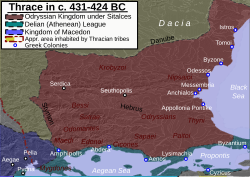
Back المملكة الأودراسية Arabic Адрыскае царства Byelorussian Одриско царство Bulgarian Regne dels odrisis Catalan Odryské království Czech Odrysen German Οδρύσες Greek Odrisia regno Esperanto Reino odrisio Spanish پادشاهی ادروسی Persian
Odrysian kingdom | |||||||||||||||||
|---|---|---|---|---|---|---|---|---|---|---|---|---|---|---|---|---|---|
| c. 480 BC–c. 30 BC | |||||||||||||||||
 The Odrysian kingdom under king Sitalces (c. 431–424) | |||||||||||||||||
| Capital | Seuthopolis (c. 330–250 BC) | ||||||||||||||||
| Common languages | Thracian Greek (used in writing and among trade and administration) | ||||||||||||||||
| Religion | Thracian polytheism | ||||||||||||||||
| Government | Monarchy | ||||||||||||||||
| Historical era | Classical antiquity | ||||||||||||||||
• Foundation | c. 480 BC | ||||||||||||||||
| 340 BC | |||||||||||||||||
• Rebellion of Seuthes III | c. 330 | ||||||||||||||||
• Destruction of Seuthopolis | c. 250 | ||||||||||||||||
• Conquest of Odrysian heartlands by the Sapaeans | c. 30 BC | ||||||||||||||||
| Area | |||||||||||||||||
• Total | 150,000 km2 (58,000 sq mi) | ||||||||||||||||
| |||||||||||||||||
| Today part of | Bulgaria Greece Turkey Romania | ||||||||||||||||
The Odrysian kingdom (/oʊˈdrɪʒən/; Ancient Greek: Βασίλειον Ὀδρυσῶν) was an ancient Thracian state that thrived between the early 5th century BC and the early 3rd / late 1st century BC. Located in present-day Bulgaria, southeastern Romania (Northern Dobruja), northern Greece and European Turkey, it was a tribal amalgam dominated by the Odrysians that was the first large political entity to develop in the eastern Balkans. Before the foundation of Seuthopolis in the late 4th century it had no fixed capital.
The Odrysian kingdom was founded by king Teres I, exploiting the collapse of the Persian presence in Europe due to failed invasion of Greece in 480–79.[2] Teres and his son Sitalces pursued a policy of expansion, making the kingdom one of the most powerful of its time. Throughout much of its early history it remained an ally of Athens and even joined the Peloponnesian War on its side. By 400 BC the state showed first signs of fatigue, although the skilled Cotys I initiated a brief renaissance that lasted until his murder in 360 BC.
Afterwards the kingdom disintegrated: southern and central Thrace were divided among three Odrysian kings, while the northeast came under the dominion of the kingdom of the Getae. The three Odrysian kingdoms were eventually conquered by the rising kingdom of Macedon under Philip II in 340 BC. A much smaller Odrysian state was revived in around 330 BC by Seuthes III, who founded a new capital named Seuthopolis that functioned until the second quarter of the 3rd century BC. After that there is little conclusive evidence for the persistence of an Odrysian state, with the exception of a dubious Odrysian king fighting in the Third Macedonian War named Cotys. The Odrysian kingdom was attacked by the Roman Republic in the late 1st century BC, when the Odrysian heartlands eventually became known as the Sapaean kingdom, a client state of the Roman Republic, which was finally abolished and converted into a Roman province of Thracia in 45-46 AD.
- ^ Kouremenos 2016, p. 46.
- ^ Rehm, Ellen (2010). "The Impact of the Achaemenids on Thrace: A Historical Review". In Nieling, Jens; Rehm, Ellen (eds.). Achaemenid Impact in the Black Sea: Communication of Powers. Black Sea Studies. Vol. 11. Aarhus University Press. p. 143. ISBN 978-8779344310.
In 470/469 BC, the strategist Kimon, mentioned above, defeated the Persian fleet at the mouth of the Eurymedon river. Subsequently, it seems that the royal house of the Odrysians in Thrace gained power and in about 465/464 BC emerged from the Persian shadow. The Odrysians became aware of the power vacuum resulting from the withdrawal of the Persians and claimed back supremacy over the region inhabited by several tribes. From this period onwards an indigenous ruling dynasty is comprehensible.
Cite error: There are <ref group=lower-alpha> tags or {{efn}} templates on this page, but the references will not show without a {{reflist|group=lower-alpha}} template or {{notelist}} template (see the help page).
